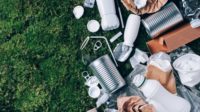Biodegradable resins have been gaining popularity since they came into the market some 10 years ago. Why? Because biopolymers are seen as sustainable alternatives to standard plastics that are heavily dependent on fossil fuels.
Several biodegradable polymers – both from renewable and non-renewable sources – are available today. These biodegradable polymers are compostable in compliance with European, US and Japanese standards for compostable and biodegradable polymers, and their use can help enhance brand positioning and eco-friendly messaging for companies that want a competitive edge when it comes to sustainability.
Among the biodegradable resins available, the most popular appears under the brand names Ecoflex and Ecovio, manufactured by BASF. Ecoflex is a completely biodegradable aliphatic-aromatic polyester which is still derived out of petroleum-based materials. But when it’s used in combination with renewable raw materials or by blending it with bio-based polymers like starch or poly (lactic acid), biodegradable plastics with new and interesting property profiles are obtained.
Ecovio is a biodegradable resin that contains up to 45 percent renewable resources; in essence, it is a compound of biodegradable copolyester Ecoflex and polylactic acid (PLA). Ecoflex and Ecovio in combination are touted as a direct replacement for polyethylene and polystyrene in wide variety of applications.
Even though biodegradable resins are gaining in prominence and finding acceptance among wide-spectrum consumers and converters, there are still some challenges to overcome in order to displace petroleum-based resins like polyethylene in most common packaging applications.
One of the biggest challenges facing biodegradable polymers are overcoming physical property constraints like poor melt strength, melt-curtain stability and barrier properties, especially moisture barrier. Process ability is another factor that needs to be closely examined. Factors like higher cost of biodegradable resins and availability are not considered for this article.
Physical Properties
Ecoflex and Ecovio blends can be processed on a blown-film line designed to run polyethylene; however they are not completely interchangeable. A combination of significantly higher density and lower processing temperature compared to LDPE and poor melt strength, makes Ecoflex a challenging material to process on best of blown film lines.
Let’s look at various components on a blown film line that may play a significant role in successful processing of these biodegradable polymers for any flexible packaging application.
Extruder and Feed Screw
A barrier type screw with a mixture in is ideal for processing. A grooved feed extruder works well in blowing of low melt strength materials but is not a must. Care must be taken to maintain grooved feed section of the extruder at as cold a temperature as possible. A tighter screen pack ensures adequate back pressure and uniform melt flow of viscous material.
Temperature
It is critical to maintain melt temperature in the range of 160 to 1900ºC, so all temperature zones on the extruder and die should be set to achieve desired melt temperature. A flat or a slight ascending profile works best for most applications.
Gravimetric Blending and Extrusion Control
Both gravimetric batch and continuous feed blending with yield control work well; however, care must be taken to ensure there are no fluctuations in screw RPM as a result of material surging in the extruder.
Specific output is significantly higher for these polymers compared to PE blends. As a result careful consideration must be given to ensure adequate balance of throughput, screw RPMs and motor load.
Air Ring – IBC – Cooling
Higher air temperature and minimum IBC supply helps stabilize the bubble. Due to the high elasticity of the material, it is very important to support the bubble by lowering the primary cage just above the die, and use a secondary cage to further support the bubble mid-way to the primary nip.
Bubble Collapsing and Haul-Off
Long A-frame and long side guides are ideal in locking and supporting the bubble as it is being collapsed. Bubble cage and collapsers play a critical part in eliminating wrinkle formation in this key area. Plastic covered slats or coated rollers work equally well in collapsing the bubble as long there is no uneven wear or flat spots which can cause unnecessary drag, causing wrinkles and bagginess in the film.
Both horizontal and vertical haul-off work well as gauge randomizer. A properly maintained turning bar with adequate air flow for cushioning the film along clean and rubber rollers help the film along to downstream equipment.
Bow rollers, spreader rollers, stretch rollers and spiral groove-rollers all help eliminate wrinkles formed in machine direction, as a result of process instability due to poor extrusion or misaligned components.
Winding
A very important part of any film production process is the collection of film on a paper core. If everything in the process is set up right and monitored, then a center winder with a lay-on roll and taper tension is adequate to wind rolls to optimum hardness.
Transitioning In and Out of Biodegradable Polymers
Transitioning in and out of a production run is just as important as an actual production. Following proper procedure eliminates cross contamination, degradation and, in rare cases, cross link of polymer. A thorough attention to the process will save both time and expensive clean up. When transitioning in or out of biodegradable polymers, the use of high-melt LDPE is recommended until all deposits, lines and gels are eliminated.
Making a Behavioral Change
Incorporating biodegradable polymers into your production is a matter of understanding the ways they behave differently from traditional materials. The right equipment and processes can help make the change smooth sailing.
The reward? Enhanced sustainability, greater perceived value and some great products that leave a lighter footprint.
Haremar Plastic Manufacturing Ltd.
(905) 761-7552; www.haremar.com





